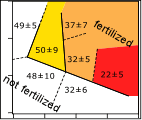 |
|
|
|
|
|
|
Economic constraints gave rise to local intensification of alpine agriculture. A high number of animals cause local nutrient enrichment, especially when additional fertilization is applied to increase productivity. Yet, with the increase in nitrogen availability species richness and diversity are considerably reduced. Unwanted species like Rumex alpinus may be able to spread. Dwarf shrubs do not tolerate fertilization and die back. As this happens the soil may be exposed to erosion. |
1 - Reduction in species richness due to fertilization (27K) |
|
Overgrazing on steep slopes, especially by heavier animals such as cattle, leads quickly to patches of bare soil, which are easily eroded. With increasing steepness and altitude, destruction of the vegetation by progressive erosion can be very fast and natural repair will be very slow. Mean weight, productivity, and resource demand of the animals have steadily increased since 1900. In Glarner Hinterland-Sernftal milk production has increased by 68% in spite of 21% fewer cows. Yet, heavier weight and higher resource demand in turn increase the mechanical impact of the animals as well as their impact through nutrient redistribution. In South America and Asia, population pressure on alpine ecosystems is increasing. Greater numbers of livestock and a shortening of the time between fires lead to changes in vegetation structure with concomitant changes in microclimate and hydrology, and to big patches of bare ground which enhance erosion. Changes in the vegetation and an increase in bare ground lead to an overall reduced ecological stability in alpine ecosystems. In recent years there have been several devastating mudslides in Colombia and other Andean countries which can be attributed, at least in part, to overgrazing of mountain pastures. |
29 August 2011 |
||
| |
||
